Discover the rejuvenating experience of nature retreats in Iceland, where stunning landscapes meet immersive activities. Explore iconic sites like glaciers, volcanic mountains, and geothermal hot springs. Engage in hiking, birdwatching, and photography opportunities, including capturing the Northern Lights. Prioritize sustainability and cultural connections to enhance your retreat experience.
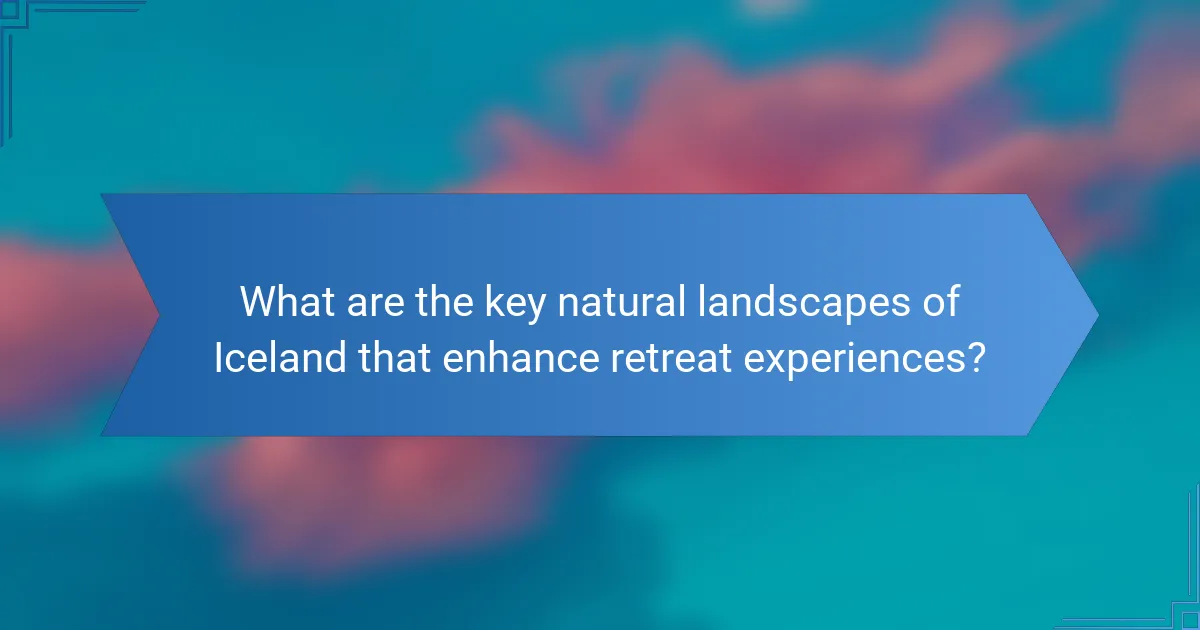
What are the key natural landscapes of Iceland that enhance retreat experiences?
Iceland’s key natural landscapes include glaciers, volcanic mountains, hot springs, and waterfalls, enhancing retreat experiences. Glaciers like Vatnajökull offer serene vistas and hiking opportunities. Volcanic mountains, such as Hekla, provide dramatic backdrops for photography. The Blue Lagoon features geothermal hot springs, promoting relaxation. Iconic waterfalls like Gullfoss create tranquil settings for mindfulness and reflection. These landscapes foster a deep connection with nature, enriching the retreat experience.
How do volcanic formations contribute to Iceland’s unique scenery?
Volcanic formations significantly enhance Iceland’s scenery through dramatic landscapes and unique geological features. These formations create striking contrasts, such as black lava fields against vibrant green moss and glacial ice. The presence of volcanoes contributes to a diverse ecosystem, attracting photographers and nature enthusiasts. Unique attributes, like the active volcanoes in the Reykjanes Peninsula, provide rare opportunities for exploration and adventure. Additionally, geothermal activity shapes hot springs and mud pots, further enriching the natural beauty of the region.
What role do glaciers play in the Icelandic landscape?
Glaciers significantly shape the Icelandic landscape by creating stunning natural features and influencing ecosystems. They carve valleys, form glacial lakes, and create unique landforms like moraines and icebergs. For example, Vatnajökull, Europe’s largest glacier, covers 8% of Iceland’s landmass, impacting local climate and biodiversity. Glaciers also provide essential water resources, feeding rivers and supporting various flora and fauna. Their dynamic nature offers photographers breathtaking vistas, especially during sunrise and sunset, enhancing Iceland’s appeal as a nature retreat.
Which coastal features are popular among nature retreat visitors?
Coastal features popular among nature retreat visitors in Iceland include dramatic cliffs, black sand beaches, and unique rock formations. These landscapes provide stunning backdrops for photography and outdoor activities. Visitors often explore locations like Reynisfjara Beach, known for its basalt columns, and the Snæfellsnes Peninsula, which offers diverse coastal scenery. The convergence of land and sea creates opportunities for birdwatching and observing marine life.
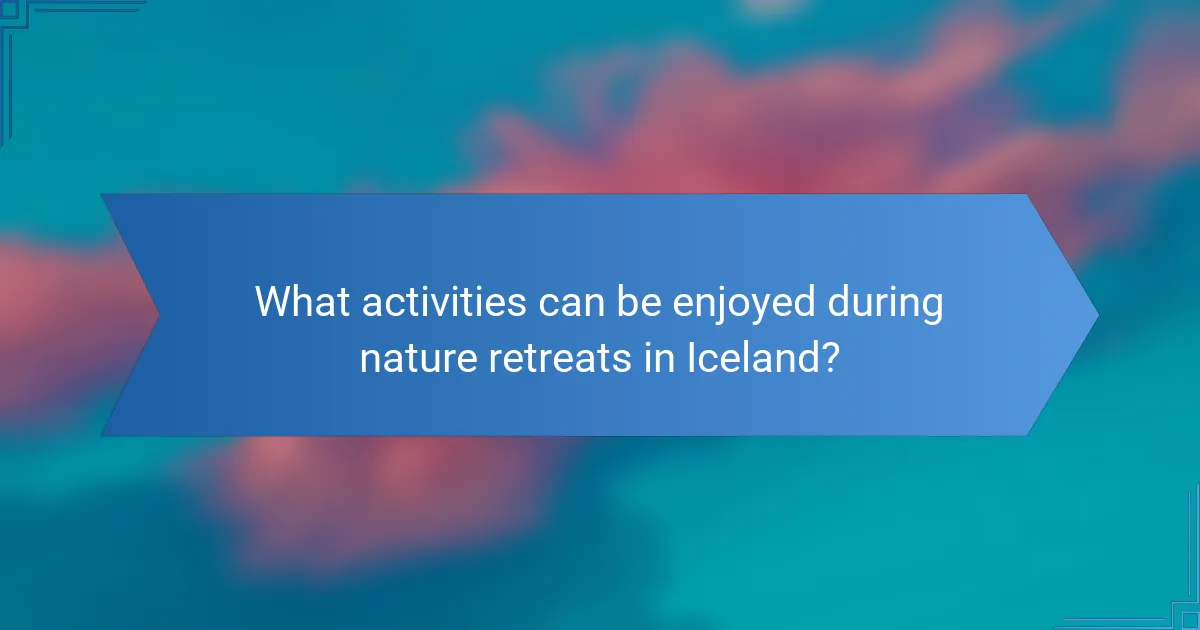
What activities can be enjoyed during nature retreats in Iceland?
Nature retreats in Iceland offer a variety of activities that immerse visitors in stunning landscapes. Hiking through diverse terrains allows exploration of waterfalls, glaciers, and volcanic craters. Birdwatching provides opportunities to observe unique species in their natural habitats. Photography enthusiasts can capture the breathtaking Northern Lights and dramatic coastal cliffs. Additionally, relaxing in geothermal hot springs enhances the rejuvenating experience of nature retreats.
How does hiking in Iceland differ across various terrains?
Hiking in Iceland varies significantly across terrains, offering diverse experiences. Glacial hikes feature icy landscapes and require special gear, while volcanic terrains present unique rock formations and geothermal activity. Coastal hikes showcase breathtaking ocean views and rugged cliffs, whereas lush valley trails provide vibrant flora and fauna. Each terrain offers distinct photography opportunities, from dramatic contrasts in color to expansive vistas.
What are the benefits of guided tours versus self-exploration?
Guided tours offer structured experiences and expert insights, while self-exploration allows for personal freedom and spontaneity. Guided tours in Iceland provide access to hidden landscapes and photography opportunities, enhancing the overall experience. Self-exploration encourages a deeper connection with nature, enabling travelers to discover unique sights at their own pace. Both options have distinct benefits, catering to different preferences and travel styles.
Which seasonal activities are most popular among retreat-goers?
Hiking, birdwatching, and photography are the most popular seasonal activities among retreat-goers in Iceland. During summer, the midnight sun allows for extended exploration, while winter attracts visitors for northern lights photography. Spring showcases vibrant flora, and autumn offers stunning foliage. Each season presents unique landscapes, enhancing the retreat experience.
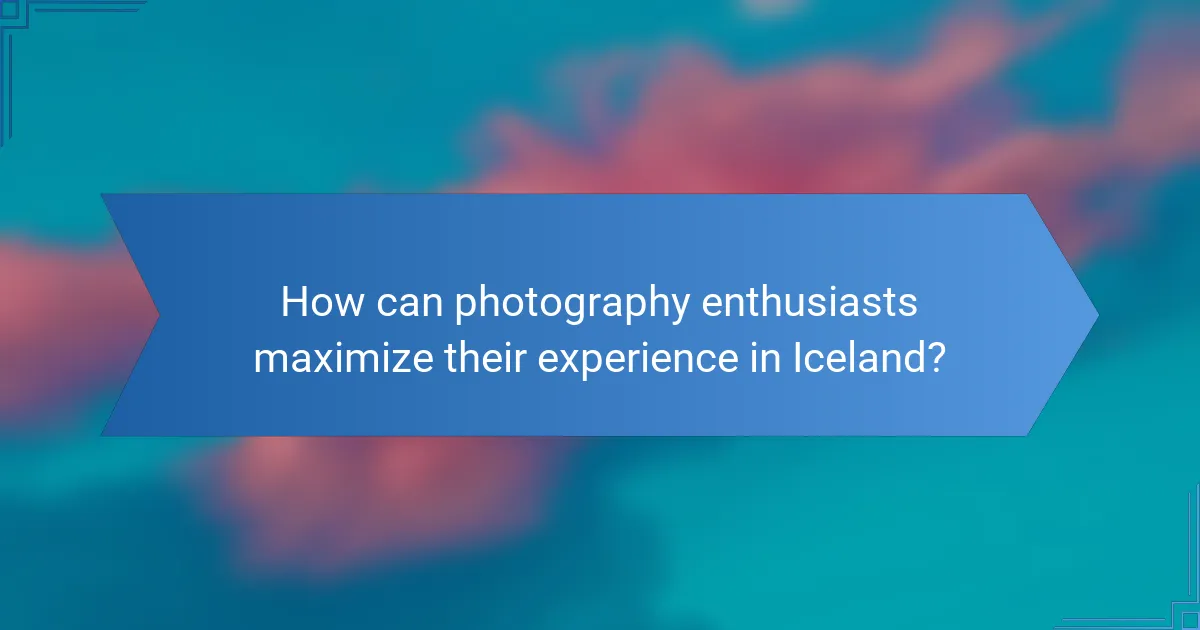
How can photography enthusiasts maximize their experience in Iceland?
Photography enthusiasts can maximize their experience in Iceland by exploring diverse landscapes and participating in unique activities. Key opportunities include visiting iconic sites like the Golden Circle, capturing the Northern Lights, and hiking in national parks.
1. Plan visits during golden hours for optimal lighting.
2. Use a tripod for stability in varying conditions.
3. Experiment with long exposure techniques at waterfalls.
4. Engage in guided photography tours for expert insights.
5. Capture wildlife, such as puffins and arctic foxes, in their natural habitats.
Iceland’s unique attributes, like its dramatic volcanic landscapes and geothermal features, provide endless inspiration for stunning photography.
What are the best times of year for landscape photography in Iceland?
The best times of year for landscape photography in Iceland are late spring through early autumn. During this period, the weather is milder, and the days are longer, providing optimal lighting conditions.
In late spring (May to June), you can capture vibrant green landscapes and blooming wildflowers. The summer months (July to August) offer stunning midnight sun opportunities, allowing for unique lighting at all hours. Early autumn (September to October) features colorful foliage and the chance to photograph the Northern Lights as nights grow darker.
Each season presents unique photographic opportunities, making Iceland a year-round destination for landscape photographers.
Which locations are renowned for stunning photographic opportunities?
Iceland is renowned for its stunning photographic opportunities, particularly in its diverse landscapes. Key locations include the Golden Circle, featuring Þingvellir National Park, Geysir Geothermal Area, and Gullfoss Waterfall. The South Coast offers iconic sites like Seljalandsfoss and Reynisfjara Beach. The Snæfellsnes Peninsula showcases dramatic cliffs and the Snæfellsjökull glacier. In the north, Lake Mývatn presents unique geological formations and rich birdlife. Each location provides photographers with breathtaking scenery and unique attributes, making Iceland a prime destination for nature photography.
How can one prepare for capturing the Northern Lights?
To capture the Northern Lights effectively, plan your trip during winter months and choose dark, remote locations. Dress warmly, use a sturdy tripod, and bring a camera with manual settings. Familiarize yourself with aurora forecasts to maximize your chances.
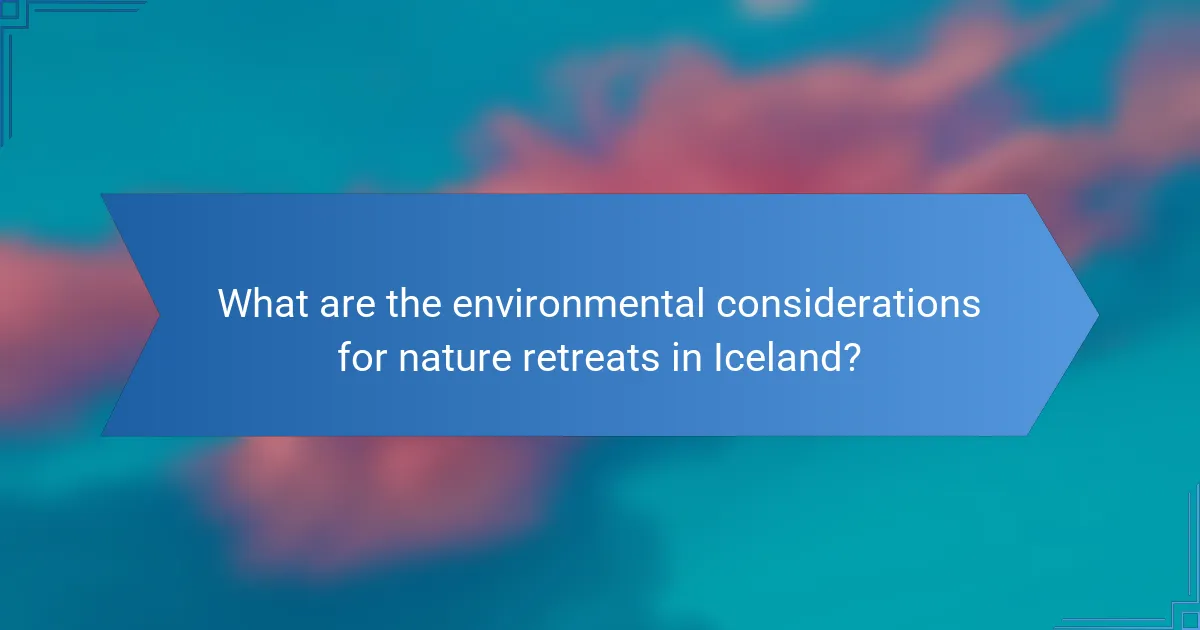
What are the environmental considerations for nature retreats in Iceland?
Nature retreats in Iceland must prioritize sustainability and respect for natural habitats. Key environmental considerations include minimizing waste, protecting wildlife, and conserving water. Tourists should choose eco-friendly accommodations and participate in low-impact activities. Additionally, promoting local culture supports sustainable tourism. These practices help preserve Iceland’s unique landscapes for future generations.
How does sustainable tourism impact Iceland’s natural landscapes?
Sustainable tourism positively impacts Iceland’s natural landscapes by promoting conservation and responsible travel practices. It encourages preservation of ecosystems and minimizes environmental degradation. Tourists engage in activities like hiking and photography, fostering appreciation for nature. As a result, local communities benefit economically while protecting unique landscapes, such as glaciers and geothermal areas. Sustainable initiatives, like eco-friendly accommodations, further enhance the preservation of these rare attributes, ensuring that Iceland’s breathtaking scenery remains intact for future generations.
What practices can retreat visitors adopt to minimize their footprint?
Retreat visitors can adopt several practices to minimize their environmental footprint. Prioritize leaving no trace by carrying out all waste, including food scraps. Use biodegradable products and opt for eco-friendly accommodations. Engage in local conservation efforts by participating in clean-up activities. Choose sustainable transport options, such as biking or walking, to explore the landscapes. Lastly, respect wildlife and natural habitats by observing from a distance and staying on marked trails.

What unique cultural elements can enhance the nature retreat experience?
Unique cultural elements such as traditional Icelandic music, folklore, and local cuisine can greatly enhance the nature retreat experience. Engaging with local artisans and participating in cultural festivals provide deeper connections to the landscape. The unique attribute of Iceland’s rich storytelling tradition allows visitors to appreciate natural sites through historical narratives. Additionally, experiencing geothermal bathing rituals offers a rare opportunity to blend wellness with cultural immersion. These elements create a holistic retreat that combines nature with Icelandic heritage.
How do local folklore and traditions influence nature retreats?
Local folklore and traditions significantly enhance nature retreats in Iceland by integrating cultural narratives with natural landscapes. Folklore often shapes the perception of Iceland’s unique terrains, such as volcanic formations and glacial valleys, making them more meaningful to visitors.
Activities like guided tours often incorporate storytelling about elves and trolls, enriching the experience. Photography opportunities are also influenced, as capturing these landscapes through the lens of local myths adds depth to the imagery.
Participants frequently engage in rituals or festivals that celebrate nature, fostering a deeper connection to the environment. This blend of culture and nature creates a holistic retreat experience, appealing to those seeking both relaxation and cultural enrichment.
Which cultural events align with nature retreat schedules?
Cultural events in Iceland often align with nature retreat schedules, enhancing the experience. Events like the Reykjavik Arts Festival, Þorrablót midwinter festival, and the Iceland Airwaves music festival coincide with nature retreats, offering unique opportunities for immersion in local culture. These events celebrate Icelandic traditions, arts, and music, providing a rich backdrop to the stunning landscapes. Participants can engage in outdoor activities while enjoying cultural performances, making the retreats more memorable.
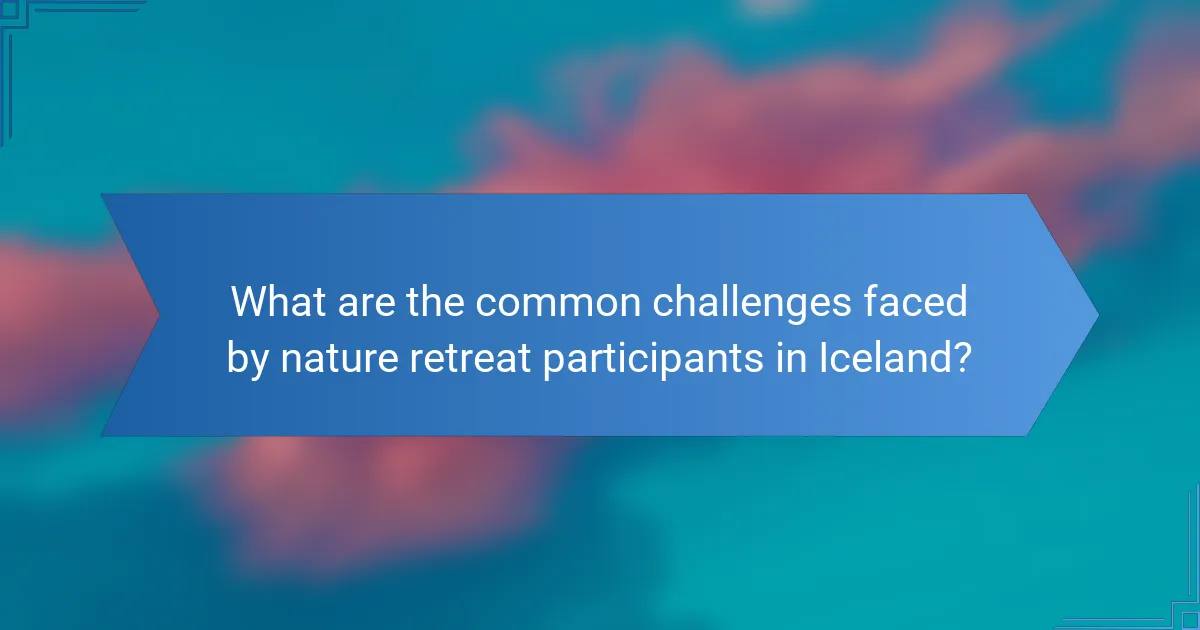
What are the common challenges faced by nature retreat participants in Iceland?
Nature retreat participants in Iceland often face challenges related to weather conditions, physical exertion, and accessibility. Unpredictable weather can hinder outdoor activities and affect overall enjoyment. The rugged terrain requires a certain level of fitness, which may not suit all participants. Additionally, remote locations can pose accessibility issues, limiting options for those with mobility concerns. These factors can impact the overall retreat experience, making preparation essential.
How can weather conditions affect retreat plans?
Weather conditions can significantly impact retreat plans in Iceland. Extreme weather may lead to changes in outdoor activities, affecting hiking, photography, and wildlife observation. For instance, heavy rain or snow can limit access to certain landscapes, while clear skies enhance photography opportunities. Seasonal variations also influence the availability of specific activities, such as glacier hiking in summer versus winter. Planning for unpredictable weather is essential to ensure a fulfilling nature retreat experience.
What safety measures should be taken during outdoor activities?
To ensure safety during outdoor activities in Iceland, follow these essential measures. Always check weather conditions before heading out. Wear appropriate clothing and footwear for varying terrains. Stay hydrated and carry sufficient food supplies. Inform someone of your itinerary and expected return time. Utilize proper equipment for activities like hiking or photography. Stay on marked trails to avoid getting lost.

What expert tips can enhance the nature retreat experience in Iceland?
To enhance the nature retreat experience in Iceland, prioritize planning, local knowledge, and mindful engagement with the environment.
First, choose the right season; summer offers lush landscapes and wildlife, while winter showcases the Northern Lights. Second, engage local guides who provide insights into Iceland’s unique geology and culture. Third, practice sustainable tourism by minimizing your ecological footprint. Fourth, invest time in photography; the dramatic scenery is best captured during golden hours. Lastly, incorporate wellness activities such as yoga or meditation to connect deeply with nature.
How to choose the right retreat based on personal preferences?
To choose the right retreat based on personal preferences, consider your interests and desired experiences. Nature retreats in Iceland offer diverse landscapes, activities, and photography opportunities that cater to various tastes.
First, evaluate the types of landscapes you prefer. Iceland features stunning waterfalls, glaciers, and geothermal areas. For example, the Golden Circle offers a mix of these landscapes in one trip.
Second, think about activities that excite you. Options include hiking, birdwatching, and exploring hot springs. Each activity provides unique experiences and ways to connect with nature.
Lastly, consider photography opportunities. Iceland’s dramatic scenery offers countless chances to capture breathtaking images. Research locations known for their photogenic qualities, such as Jökulsárlón Glacier Lagoon or the black sand beaches of Vik.
By assessing these factors, you can select a retreat that aligns with your personal preferences and enhances your overall experience.
What essentials should be packed for an Icelandic nature retreat?
Pack essentials like waterproof clothing, sturdy hiking boots, a camera, and a power bank for your Icelandic nature retreat. These items enhance your experience by ensuring comfort and capturing the stunning landscapes. Include a reusable water bottle and snacks to stay hydrated and energized during outdoor activities. Don’t forget a map or GPS device to navigate Iceland’s diverse terrains effectively.
What are common mistakes to avoid during a nature retreat in Iceland?
To avoid common mistakes during a nature retreat in Iceland, plan your itinerary carefully, respect local wildlife, and prepare for unpredictable weather.
1. Underestimating travel time between locations can lead to missed experiences.
2. Ignoring local guidelines can disrupt ecosystems and harm wildlife.
3. Failing to dress in layers may result in discomfort due to rapid weather changes.
4. Neglecting to charge camera equipment can lead to missed photography opportunities.
5. Overpacking can hinder mobility during outdoor activities.
6. Skipping research on local customs may lead to cultural misunderstandings.